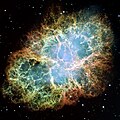Պատկեր:Crab Nebula.jpg
Արտաքին տեսք

Նախադիտման չափ՝ 600 × 600 պիքսել։ Այլ թույլտվությաններ: 240 × 240 պիքսել | 480 × 480 պիքսել | 768 × 768 պիքսել | 1024 × 1024 պիքսել | 2048 × 2048 պիքսել | 3864 × 3864 պիքսել.
Սկզբնական նիշք (3864 × 3864 փիքսել, նիշքի չափը՝ 13,84 ՄԲ, MIME-տեսակը՝ image/jpeg)
Նիշքի պատմություն
Մատնահարեք օրվան/ժամին՝ նիշքի այդ պահին տեսքը դիտելու համար։
| Օր/Ժամ | Մանրապատկեր | Օբյեկտի չափը | Մասնակից | Մեկնաբանություն | |
|---|---|---|---|---|---|
| ընթացիկ | 14:56, 25 Նոյեմբերի 2012 |  | 3864 × 3864 (13,84 ՄԲ) | Hawky.diddiz | Lossless optimization |
| 10:13, 17 Մայիսի 2012 |  | 3864 × 3864 (14,61 ՄԲ) | Metrónomo | Higher quality | |
| 09:31, 20 Հունիսի 2009 |  | 3864 × 3864 (6,18 ՄԲ) | Tryphon | Higher resolution. | |
| 21:26, 9 Մարտի 2006 |  | 2224 × 2212 (3,08 ՄԲ) | Stianbh | larger version | |
| 00:35, 16 հունվարի 2006 |  | 400 × 400 (23 ԿԲ) | DragonFire1024 | Image: A New View of the Helix Nebula Source: http://hubblesite.org/gallery/album/entire_collection/pr2004032d/ Copyright Notice: Material credited to STScI on this site was created, authored, and/or prepared for NASA under Contract NAS5-26555. Unless |
Նիշքի օգտագործում
More than 100 pages use this file. The following list shows the first 100 pages that use this file only. A full list is available.
- (10031) Վլադառնոլդա
- (10054) Սոլոմին
- (10295) Հիպոլիտա
- (10347) Մուրոմ
- (10370) Հիլոնոմ
- (10416) Կոտլեր
- (10537) 1991 RY16
- (10563) Իզդուբար
- (10664) Ֆեմիոս
- (10711) Պսկով
- (10792) Էկվադոր
- (10797) Գվատեմալա
- (10806) Մեխիկո
- (10866) Պերու
- (11066) Սիգուրդ
- (11284) Բիլենուս
- (11311) Պիլեուս
- (11500) Տոմաիյովիտ
- (11788) Նաուչնի
- (11881) Միրսթեյշն
- (11885) Սամանուս
- (11947) Կիմքլիյստեր
- (11948) Ջասթինհենին
- (12008) Քանդրուփ
- (12219) Գրիգորև
- (12658) Պեյրայոս
- (12711) Տակմիտ
- (12714) Ալկիմոս
- (12923) Զեֆիր
- (12972) Էումայոս
- (12973) Մելենթիոս
- (12974) Հալիտերսես
- (13062) Պոդարկես
- (13181) Պինելիոս
- (13184) Ավգեաս
- (13185) Ագասթենես
- (13229) Էքիոն
- (13387) Այրուս
- (13406) Սեկորա
- S/2004 S 12
- S/2004 S 13
- S/2004 S 17
- S/2004 S 7
- S/2006 S 1
- S/2006 S 3
- S/2007 S 2
- S/2007 S 3
- S/2009 S 1
- Անֆա (արբանյակ)
- Աստղագիտական մարմին
- Ատլաս (արբանյակ)
- Բեստլա (արբանյակ)
- Բերգելմիր (արբանյակ)
- Բեֆինդ (արբանյակ)
- Գրեյպ (արբանյակ)
- Դափնիս (արբանյակ)
- Դիոնա (արբանյակ)
- Դիսնոմիա
- Էգեոն (արբանյակ)
- Էգիր (արբանյակ)
- Էնցելադ (արբանյակ)
- Էրրիպո (արբանյակ)
- Թարվոս (արբանյակ)
- Թետիս (արբանյակ)
- Իմիր (արբանյակ)
- Իջիրակ (արբանյակ)
- Լոգի (արբանյակ)
- Կալիպսո (արբանյակ)
- Կարի (արբանյակ)
- Կիվիոկ (արբանյակ)
- Հաթի (արբանյակ)
- Հեղինե (արբանյակ)
- Հիպերիոն (արբանյակ)
- Հիրրոկկին (արբանյակ)
- Մեծ կիսաառանցք
- Մետոնա (արբանյակ)
- Միմաս (արբանյակ)
- Մունդիլֆարի (արբանյակ)
- Յանուս (արբանյակ)
- Յարսակսա (արբանյակ)
- Նարվի (արբանյակ)
- Պալիակ (արբանյակ)
- Պալլենա (արբանյակ)
- Պան (արբանյակ)
- Պանդորա (արբանյակ)
- Պոլիդեվկ (արբանյակ)
- Պրոմեթևս (արբանյակ)
- Ռեա (արբանյակ)
- Սիարնակ (արբանյակ)
- Սկաթի (արբանյակ)
- Սկոլլ (արբանյակ)
- Սութունգ (արբանյակ)
- Սուրտ (արբանյակ)
- Տարկեկ (արբանյակ)
- Տելեստո (արբանյակ)
- Տրյում (արբանյակ)
- Քարոն (արբանյակ)
- Ֆարբուտի (արբանյակ)
- Ֆենրիր (արբանյակ)
- Ֆիբի (Սատուրնի արբանյակ)
View more links to this file.
Նիշքի համընդհանուր օգտագործում
Հետևյալ այլ վիքիները օգտագործում են այս նիշքը՝
- Օգտագործումը af.wikipedia.org կայքում
- 1054
- Wikipedia:Uitgesoekte herdenkings/22 April
- Wikipedia:Uitgesoekte herdenkings/Julie
- Wikipedia:Uitgesoekte herdenkings/April
- Wikipedia:Uitgesoekte herdenkings/4 Julie
- Supernova
- Ster
- Wikipedia:Beeld van die week/2012
- Wikipedia:Voorbladbeeld week 2 2012
- Newel
- Kompakte ster
- Veranderlike ster
- Lys van Messier-voorwerpe
- Krapnewel
- Portaal:Sterrekunde/Inleiding
- Portaal:Sterrekunde
- Hemelliggaam
- Lys van planetêre newels
- SN 1054
- Supernova-oorblyfsel
- Sterevolusie
- Օգտագործումը als.wikipedia.org կայքում
- Օգտագործումը am.wikipedia.org կայքում
- Օգտագործումը anp.wikipedia.org կայքում
- Օգտագործումը ar.wikipedia.org կայքում
- مجرة
- نجم
- سنة
- تطور النجوم
- ثلاثي الكربون
- فجر
- مستعر أعظم
- بوابة:علم الفلك/مقالة مختارة
- شهاب
- مطلع مستقيم
- جمعية منسا الدولية
- علم الفلك خارج المجري
- عنقود نجمي
- فيلا (أقمار اصطناعية)
- الشلياق
- خرزات بيلي
- راية الأرض
- سمت
- نظرية الحالة الثابتة
- حياة الحيوان الكبرى
- توهج القمر الصناعي
- بوابة:الفيزياء/بوابات ذات علاقة
- بوابة:الفضاء
- الظهر
- اقتران (علم الفلك)
Տեսնել այս նիշքի ավելի համընդհանուր օգտագործումը:

